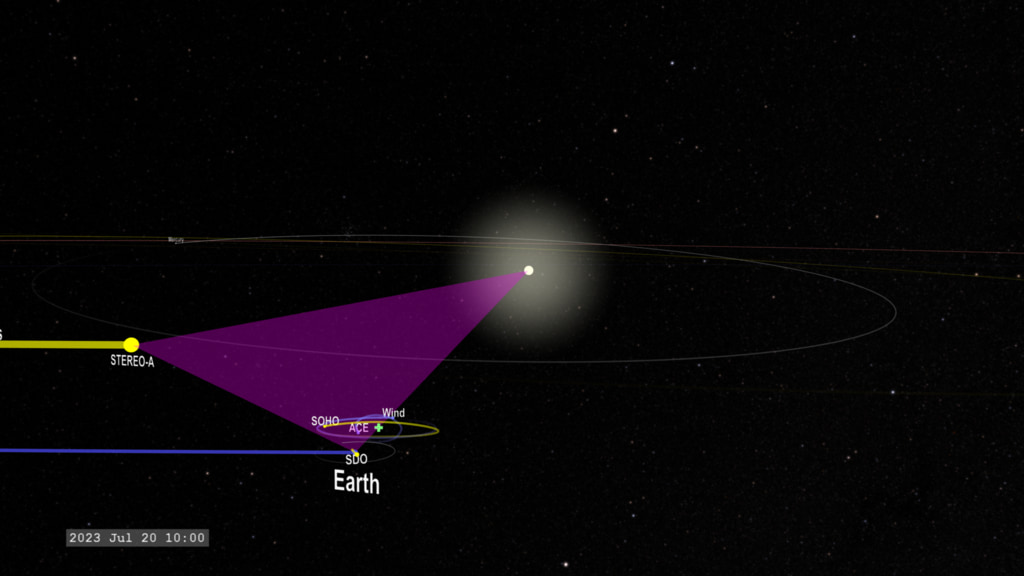STEREO's Routes to Solar Orbits
The two STEREO spacecraft, A (red path) and B (yellow path), are launched from the Earth into a highly eccentric orbit with an apogee that reaches the orbit of the Moon. Once in this orbit, the trajectories are adjusted so they can receive gravity-assists from the Moon. The gravity assist will send them both into heliocentric orbits, one spacecraft ahead of the Earth and the other behind the Earth.
This trajectory was generated using a spacecraft ephemeris generated shortly after launch.
This movie illustrates the lunar gravity assist that sends the STEREO spacecraft into their heliocentric orbit. This version has date labels.
This movie illustrates the lunar gravity assist that sends the STEREO spacecraft into their heliocentric orbit. This version does not have date labels.
This movie has a slightly altered camera path and rendered in Left/Right eye pairs for stereo projection.

STEREO A and B speed away from the Earth. Currently their trajectories are too close together to distinguish as separate spacecraft.

STEREO A and B speed away from the Earth. Currently their trajectories are too close together to distinguish as separate spacecraft. This version has no date information.

The spacecraft leave the Earth behind.

The spacecraft leave the Earth behind. This is the 'no date' version.

The spacecraft pass apogee, at the orbit of the Moon. The Moon and it's orbit are represented by the white sphere and green curve.

The spacecraft pass apogee, at the orbit of the Moon. The Moon and it's orbit are represented by the white sphere and green curve. This is the 'no date' version.

STEREO continues in geocentric orbit, waiting for the Moon to reach the optimum position.

STEREO continues in geocentric orbit, waiting for the Moon to reach the optimum position. This is the 'no date' version.

As the Moon passes, STEREO moves behind, receiving a gravitational nudge which increases its speed.

As the Moon passes, STEREO moves behind, receiving a gravitational nudge which increases its speed. This is the 'no date' version.

The spacecraft move out from the Earth-Moon system. This is the 'no date' version.

While STEREO A continues outward, STEREO B doesn't have quite enough speed and curves back Earthward, receiving an extra boost from the Moon.

While STEREO A continues outward, STEREO B doesn't have quite enough speed and curves back Earthward, receiving an extra boost from the Moon. This is the 'no date' version.

Relative to the Earth, STEREO A appears to move towards the Sun while STEREO B moves away from the Sun. The Sun moves into the field of view.

Relative to the Earth, STEREO A appears to move towards the Sun while STEREO B moves away from the Sun. The Sun moves into the field of view. This is the 'no date' version.

By April, 2007, the two STEREO spacecraft have left the Earth and Moon far behind.

By April, 2007, the two STEREO spacecraft have left the Earth and Moon far behind. This is the 'no date' version.
Credits
Please give credit for this item to:
NASA/Goddard Space Flight Center Scientific Visualization Studio
-
Animators
- Tom Bridgman (Global Science and Technology, Inc.)
- Walt Feimer (HTSI)
-
Scientists
- Therese Kucera (NASA/GSFC)
- Michael Kaiser (NASA/GSFC)
Release date
This page was originally published on Wednesday, February 7, 2007.
This page was last updated on Wednesday, May 3, 2023 at 1:55 PM EDT.
Missions
This visualization is related to the following missions:Series
This visualization can be found in the following series:Datasets used in this visualization
-
[STEREO]
ID: 169The STEREO mission consists of two Sun-observing spacecraft that will travel around the Sun on orbits slightly inside and slightly outside Earth's orbit.
This dataset can be found at: https://stereo.gsfc.nasa.gov
See all pages that use this dataset -
SSCweb ephemerides (SSCweb)
ID: 538Satellite ephemerides
This dataset can be found at: http://sscweb.gsfc.nasa.gov
See all pages that use this dataset
Note: While we identify the data sets used in these visualizations, we do not store any further details, nor the data sets themselves on our site.
